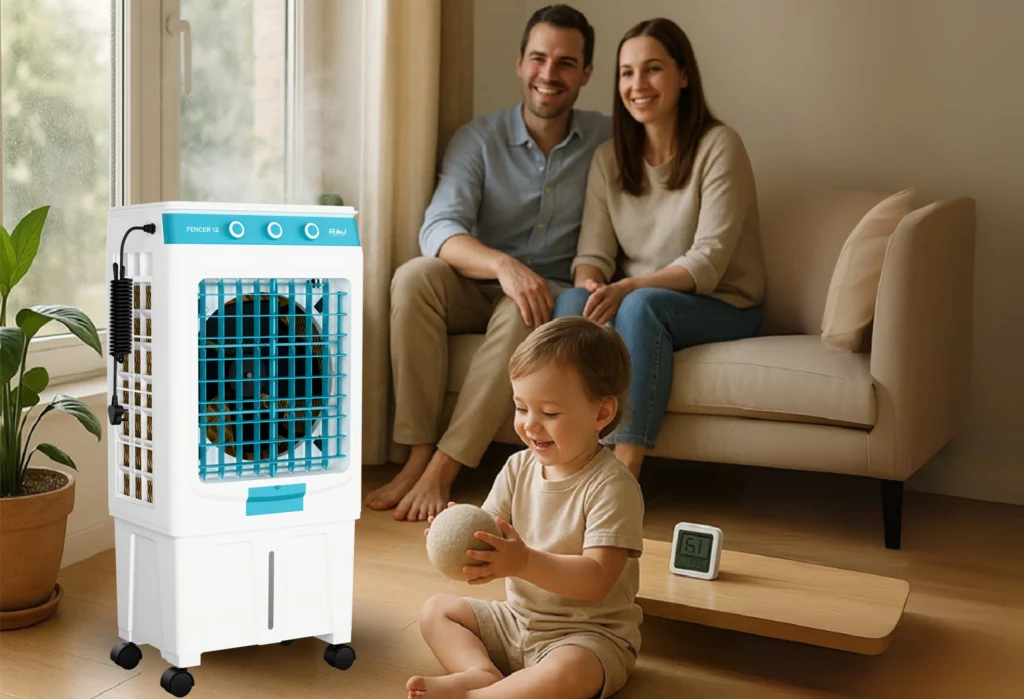When it comes to finding the right cooling solution for your home, one question pops up more often than you might think: “Does an air cooler increase humidity?” It’s a valid concern, especially for homeowners who want to create a comfortable living environment without dealing with dampness or stickiness.
Air coolers, often referred to as evaporative coolers, have gained popularity in recent years because they are affordable, eco-friendly, and energy-efficient. But they don’t work the same way as air conditioners or fans, which sometimes leads to confusion about their effect on indoor humidity. Understanding how they function can help you decide if they’re the right choice for your space and climate. In this article, we’ll break down how air coolers interact with moisture in the air, when this added humidity is beneficial, when it becomes a problem, and how to manage it effectively.
A Simple Look at the Evaporative Cooling Process
To truly understand whether an air cooler increases humidity, let’s take a closer look at how it operates. At the heart of every air cooler is a natural process called evaporative cooling a method humans have relied on for centuries to beat the heat.
Here’s how it works in a home cooler: the device comes with a water tank that continuously pumps water into special cooling pads, often made from honeycomb or aspen material. When you switch the cooler on, its fan draws in warm, dry air from the surroundings. As this hot air passes through the wet pads, the water begins to evaporate. This evaporation process absorbs heat from the air, causing the temperature to drop significantly. Finally, the fan pushes this cooled, moisture-rich air into your room, creating a refreshing breeze.
You can think of it like how your body cools down through sweating. When sweat on your skin evaporates, it carries away heat, leaving you feeling cooler. Similarly, the evaporation inside an air cooler creates naturally chilled air. The key difference is that this cooled air carries extra water vapor, which gradually increases the humidity levels in the room.
This natural cooling method makes air coolers incredibly efficient and eco-friendly, but it also explains why their performance and the resulting comfort level can vary so much depending on the climate. In dry areas, the added moisture is a blessing, while in already humid places, it can create challenges.
Does an Air Cooler Actually Increase Humidity?
The simple answer is yes, an air cooler does increase humidity. When an air cooler blows out air, it carries small water particles that were added through the evaporation process. These water particles increase the amount of moisture in the room, gradually raising its humidity levels.
For example, if you use an air cooler in a dry climate, where humidity levels are naturally low (around 20–30%), the additional moisture can make the air feel more refreshing and comfortable. This added humidity also prevents problems such as dry skin, chapped lips, and respiratory irritation. However, if you live in a coastal or already humid area with high humidity levels (70% or higher), using an air cooler can make the room feel damp and sticky. Instead of cooling you down, the added humidity may actually make you sweat more, making the room feel even hotter and less comfortable.
When Increased Humidity Is Good
In some situations, the extra humidity provided by an air cooler is beneficial. This is especially true in dry regions such as Rajasthan, Arizona, or parts of the Middle East, where the air lacks moisture. In these places, dry air can cause skin dryness, cracked lips, and respiratory problems like throat irritation and allergies. An air cooler adds moisture to the air, balancing the environment and making it more comfortable and healthy for people living there.
Moist air can also provide relief from sinus problems and help people with allergies by preventing dryness in the respiratory tract. Additionally, the cooling process works best when the surrounding air is dry because evaporation happens more quickly, making the cooler more efficient. Therefore, in dry climates, air coolers not only provide effective cooling but also naturally improve indoor comfort.
When Increased Humidity Is Bad
However, in areas where the climate is already humid, increased humidity can lead to problems. When there is too much moisture in the air, it creates a heavy and stuffy feeling inside the room. Instead of feeling cool and comfortable, you may feel sticky and sweaty, as your body struggles to evaporate sweat due to the moisture-laden air.
High humidity also creates the perfect conditions for the growth of mold, mildew, and bacteria. These microorganisms can affect your health, especially if you have asthma or allergies, and can also damage wooden furniture, walls, and fabrics. In addition, high humidity reduces the cooling efficiency of an air cooler. Since the surrounding air is already saturated with moisture, the water in the cooling pads does not evaporate quickly, which means the cooler cannot lower the temperature effectively. This results in more energy use without the desired level of comfort.
Air Cooler vs. Other Cooling Methods
When comparing cooling devices, it’s important to understand how they interact with humidity. Fans simply circulate the air without changing humidity levels, so they neither add nor remove moisture. Air conditioners, on the other hand, are designed to reduce humidity by removing moisture from the air. This makes them ideal for humid climates.
Air coolers add moisture to the air because of their evaporative process, which makes them a perfect choice for dry regions but not ideal for areas where the humidity is already high.
| Cooling Method | Effect on Humidity | Best For |
|---|---|---|
| Air Cooler | Increases humidity by adding moisture to the air | Dry and arid climates |
| Fan | Does not change humidity, just circulates existing air | Any region |
| Air Conditioner (AC) | Decreases humidity by removing moisture from the air | Humid or coastal regions |
Tips to Manage Humidity with Air Coolers
If you live in a moderately humid area and still want to use an air cooler, there are steps you can take to manage the moisture levels. Proper ventilation is essential. Keeping windows or doors slightly open allows excess moisture to escape while bringing in fresh, dry air from outside. This prevents the buildup of humidity inside the room.
On days when the outdoor humidity is already high, try to limit your cooler usage or switch to a fan or AC instead. Placing the cooler near an open window helps it draw in dry air, which improves its efficiency while preventing the room from becoming too damp.
Regular maintenance is also important. Cleaning the water tank and cooling pads regularly prevents mold and bacteria from thriving in damp areas. For even better control, consider using a hygrometer to monitor indoor humidity levels so you can adjust your cooling strategy as needed.
Conclusion
So, does an air cooler increase humidity? The answer is yes. Air coolers add moisture to the air as part of their natural evaporative cooling process. This can be a huge advantage in dry climates, where it provides both cooling and comfort by balancing indoor moisture levels. However, in areas where the climate is already humid, an air cooler may cause discomfort, encourage mold growth, and reduce cooling efficiency.
The key is to match your cooling device to your climate. For dry or arid areas, an air cooler is an energy-efficient and affordable option. For humid or coastal regions, a fan or air conditioner is usually a better choice. By understanding how an air cooler works and following proper ventilation and maintenance practices, you can enjoy a comfortable home environment while managing humidity effectively.

